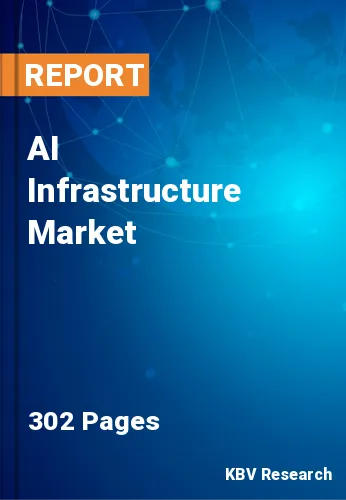The Global AI Infrastructure Market size is expected to reach $122.8 billion by 2028, rising at a market growth of 24.7% CAGR during the forecast period.
Platforms for building intelligent applications that really are predictive, self-healing, and need little human interaction are known as artificial intelligence (AI) infrastructure. Innovative technologies such as Mobility, IoT, and Big Data are straining IT infrastructure. More than ever, the requirement for intelligent infrastructure is essential for maximizing the potential of AI systems. Every stage of the machine learning workflow is supported by AI infrastructure.
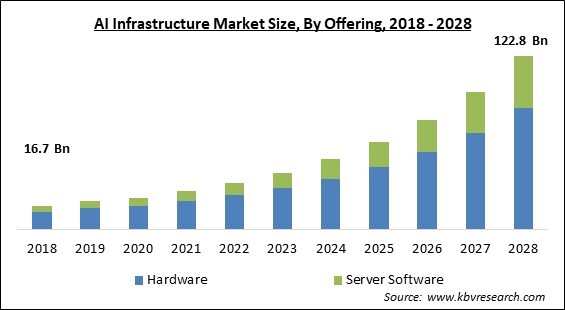
It enables the management and availability of computer resources for the development, testing, and deployment of AI algorithms by data engineers, data scientists, DevOps teams, and software developers. The workload is mapped to the appropriate setup of servers and virtual machines using AI infrastructure. Organizations can now concentrate on resource use, capacity planning, storage management, anomaly detection,
The market for AI infrastructure is expanding as a result of rising adoption of cloud machine learning platforms in businesses and rising demand for AI hardware in strong computing data centres. The market for AI infrastructure is anticipated to grow as the use of Ai technologies in vertical industries like healthcare, BFSI, automotive, and tourism increases. The market for AI infrastructure is also expanding for other reasons.
As businesses increase operational effectiveness and cut costs by automating process flows, they are coming to see the value of integrating artificial intelligence (AI) into their business operations. As a result, businesses have started utilizing autonomous processes to enhance operations and transform customer service (for instance, through chatbots driven by AI), all the while catalyzing creativity to new heights.
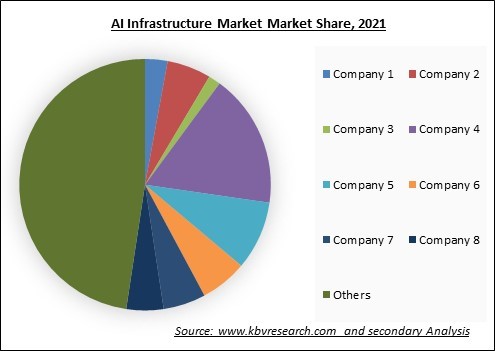
The leading players in the market are competing with diverse innovative offerings to remain competitive in the market. The below illustration shows the percentage of revenue shared by some of the leading companies in the market. The leading players of the market are adopting various strategies in order to cater demand coming from the different industries. The key developmental strategies in the market are Acquisitions.
Due to the dynamic nature of cloud services and their ability to handle unanticipated surges in service demand, the COVID-19 outbreak led many enterprises to expedite their migrations to public cloud solutions. In the era of COVID-19, cloud migrations let enterprises reimagine how they run their operations. Numerous cloud providers now deliver AIaaS and MLaaS due to the increase in demand for AI services. Due to this, the healthcare sector of the cloud market had significant growth in 2020. A lot of AI and ML technology is being employed to combat COVID-19.
In data centres, CPUs are utilised for serial computing to keep track of a number of memory regions where data and instructions are kept. A processor analyses the instructions and data at the memory locations to perform computations in serial. The steps of a computation are logically ordered and sequential in serial computation. In addition, a processor at a data centre divides a single task into a number of distinct instructions sets that are carried out in a serial fashion. This frequently causes latency issues in data centres, especially when performing AI-based calculations with large data and instruction sets.
In order to keep up with the growing volume of data created by applications, advanced AI solutions frequently necessitate new hardware and software. These AI-based solutions, for instance, require updates regarding the annotation and collection of data sources, as well as the creation, processing, and fine-tuning of models when more data becomes available. Deep learning, a branch of AI technology, has grown to be one of the most significant computational workloads for businesses and will increase the use of AI infrastructure.
Companies need expertise and a competent team to create, manage, and integrate AI systems because they are a complicated system. People working with AI systems must be knowledgeable about technologies including machine intelligence, deep learning, machine learning (ML), image recognition, and cognitive computing. Additionally, it is a difficult undertaking that necessitates well-funded internal R&D and patent filing to integrate AI technology into already-existing systems. Even small mistakes can result in system failure or solution malfunction, which can have a significant impact on the result and intended results.
On the basis of offering, the AI infrastructure market is segmented into Hardware and Server Software. Hardware segment procured the highest revenue share in the AI infrastructure market in 2021. Processors, storage, memory, and interconnects are hardware components needed to create an AI infrastructure. Smaller, more effective, and more potent xeromorphic chip-based systems are anticipated to displace huge hardware devices in the upcoming years due to the rapid advancement of technology.
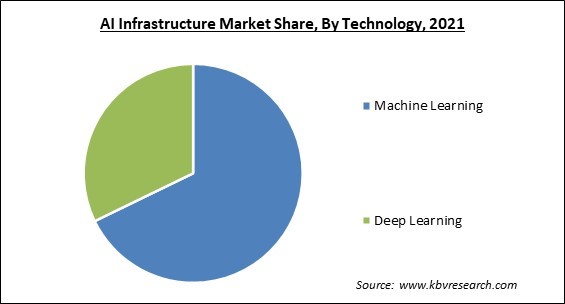
Based on technology, the AI infrastructure market is classified into Machine Learning and Deep Learning. Machine Learning segment registered the largest revenue share in the AI infrastructure market in 2021. It is because it aids in the development of new goods and provides businesses with a picture of trends in consumer behaviour and operational business patterns. A significant portion of the operations of numerous of today's top businesses, like Google, Facebook, and Uber, revolve around machine learning.
By function, the AI infrastructure market is bifurcated into Training and Inference. Training segment registered a significant revenue share in the AI infrastructure market in 2021. The cloud is a great place to train algorithms because it gives users access to enormous data repositories across many servers. The more data an AI application evaluates during training, the more effective its algorithm would become.
On the basis of deployment, the AI infrastructure market is fragmented into On-premises, Cloud and Hybrid. The cloud deployment mode segment procured the highest revenue share in the AI infrastructure market in 2021. Reduced operational expenses, fuss-free deployment, high scalability, speedy data accessibility, quicker access to crucial data, and low capital requirements are just a few advantages of cloud deployment mode.
Based on end-user, the AI infrastructure market is categorized into Enterprises, Government Organizations and Cloud Service Providers. The enterprises segment procured a significant revenue share in the AI infrastructure market in 2021. Through the usage of artificial intelligence, numerous businesses around the world are finding new insights, revenue, and efficiencies (AI). Companies are also learning that by changing the way they approach their infrastructure, they may speed up their initiatives.
| Report Attribute | Details |
|---|---|
| Market size value in 2021 | USD 26.8 Billion |
| Market size forecast in 2028 | USD 122.8 Billion |
| Base Year | 2021 |
| Historical Period | 2018 to 2020 |
| Forecast Period | 2022 to 2028 |
| Revenue Growth Rate | CAGR of 24.7% from 2022 to 2028 |
| Number of Pages | 302 |
| Number of Tables | 504 |
| Report coverage | Market Trends, Revenue Estimation and Forecast, Segmentation Analysis, Regional and Country Breakdown, Market Share Analysis, Competitive Landscape, Companies Strategic Developments, Company Profiling |
| Segments covered | Offering, End user, Deployment Type, Function, Technology, Region |
| Country scope | US, Canada, Mexico, Germany, UK, France, Russia, Spain, Italy, China, Japan, India, South Korea, Singapore, Malaysia, Brazil, Argentina, UAE, Saudi Arabia, South Africa, Nigeria |
| Growth Drivers |
|
| Restraints |
|
Region-wise, the AI infrastructure market is analyzed across North America, Europe, Asia Pacific and LAMEA. Asia Pacific registered a promising revenue share in the AI infrastructure market in 2021. The development of AI data centres in China is continuing to change as more domestic and international businesses switch to cloud service providers (CSPs) and co-location options. Due to companies looking for better connection and scalable solutions for their expanding enterprises, the need for AI data centres in the nation has surged.
Free Valuable Insights: Global AI Infrastructure Market size to reach USD 122.8 Billion by 2028
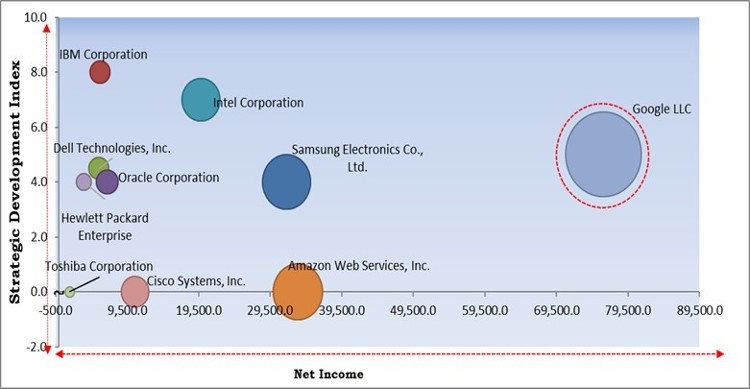
The major strategies followed by the market participants are Acquisitions. Based on the Analysis presented in the Cardinal matrix; Google LLC is the forerunners in the AI Infrastructure Market. Companies such as Intel Corporation, Samsung Electronics Co., Ltd., IBM Corporation are some of the key innovators in AI Infrastructure Market.
The market research report covers the analysis of key stake holders of the market. Key companies profiled in the report include Oracle Corporation, Intel Corporation, Samsung Electronics Co., Ltd. (Samsung Group), IBM Corporation, Google LLC, Amazon Web Services, Inc. (Amazon.com, Inc.), Hewlett-Packard Enterprise Company, Cisco Systems, Inc., Dell Technologies, Inc., and Toshiba Corporation.
By Offering
By End User
By Deployment Type
By Function
By Technology
By Geography
The AI Infrastructure Market size is projected to reach USD 122.8 billion by 2028.
Increasing Focus On Parallel Computing In Ai Data Centers are driving the market in coming years, however, Absence Of Skilled Professionals In The Market restraints the growth of the market.
Oracle Corporation, Intel Corporation, Samsung Electronics Co., Ltd. (Samsung Group), IBM Corporation, Google LLC, Amazon Web Services, Inc. (Amazon.com, Inc.), Hewlett-Packard Enterprise Company, Cisco Systems, Inc., Dell Technologies, Inc., and Toshiba Corporation.
The expected CAGR of the AI Infrastructure Market is 24.7% from 2022 to 2028.
The Cloud Service Providers segment acquired maximum revenue share in the Global AI Infrastructure Market by End user in 2021 thereby, achieving a market value of $59 billion by 2028.
The North America market dominated the Global AI Infrastructure Market by Region in 2021, and would continue to be a dominant market till 2028; thereby, achieving a market value of $42,865.5 million by 2028.
Our team of dedicated experts can provide you with attractive expansion opportunities for your business.
